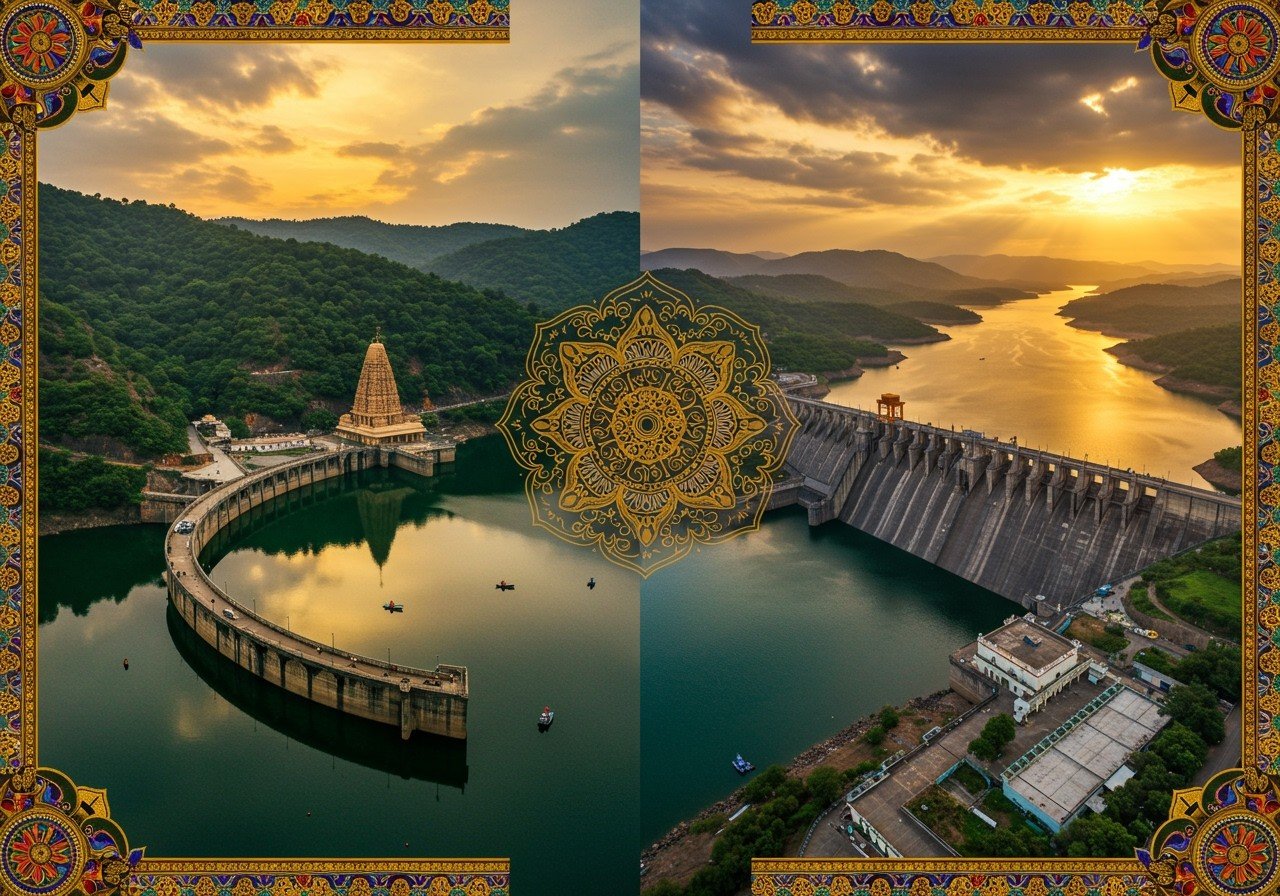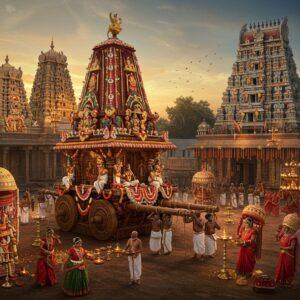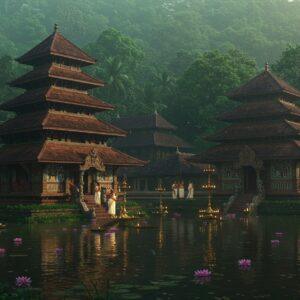
India’s iconic Srisailam and Nagarjuna Sagar Dams stand as testaments to human ingenuity, harnessing the power of the Krishna River for the benefit of millions. These aren’t just feats of engineering; they are deeply intertwined with the socio-economic fabric of the region, playing vital roles in irrigation, power generation, and cultural preservation. For culturally rooted Indians, these dams represent a harmonious blend of modernity and tradition, echoing the values we hold dear.
A Journey Through Time: Construction and Historical Significance
The Nagarjuna Sagar Dam, completed in 1967, stands as a symbol of India’s post-independence aspirations for progress and self-sufficiency. It was a pioneering project of its time, one of the earliest large-scale irrigation projects envisioned to propel the Green Revolution. The Srisailam Dam, completed in 1981, began its journey as a hydroelectric project, showcasing the nation’s growing technical expertise. Both projects faced numerous hurdles during construction, from technological limitations to the delicate task of balancing development with the needs of local communities. These dams hold a special place in the region’s history, shaping its development trajectory and leaving a lasting impact on the lives of its people.
Engineering Marvels: Technical Specifications and Capabilities
The Srisailam and Nagarjuna Sagar Dams showcase the brilliance of Indian engineering. Nagarjuna Sagar, with its imposing height of 124.663 meters and a sprawling length of 1.6 kilometers, is recognized as one of the world’s longest masonry dams. Its vast reservoir holds an astounding 11.472 billion cubic meters of water. Srisailam Dam, standing tall at 145 meters, boasts a gross storage capacity of 6.116 cubic kilometers. Beyond their impressive dimensions, these dams are lifelines for the region. Srisailam, being the second largest operating hydroelectric station in India, plays a crucial role in powering homes, industries, and progress. Nagarjuna Sagar, with its 26 flood gates, offers vital flood control, safeguarding lives and livelihoods. This intricate dance between water management and power generation underscores their significance in the region’s growth.
Nourishing the Land: Irrigation and Agricultural Impact
The impact of these dams on agriculture is transformative. Nagarjuna Sagar Dam, with its extensive canal system – the largest in India – irrigates over 1.4 million hectares of land, breathing life into the agricultural landscape of Andhra Pradesh and Telangana. Srisailam Dam, irrigating approximately 2,000 square kilometers, not only supports local agriculture but also contributes to the Telugu Ganga project, a lifeline providing drinking water to Chennai. These dams are a boon to farmers, ensuring a reliable source of water even during dry spells, and fostering food security for millions.
Balancing Progress and Nature: Environmental and Ecological Considerations
The construction of such massive projects inevitably brings environmental considerations to the forefront. The creation of large reservoirs has resulted in the submergence of forests and displacement of wildlife. Ongoing efforts like afforestation programs and wildlife sanctuaries strive to maintain a delicate balance between development and ecological preservation. Changes in local fisheries and aquatic biodiversity also require careful monitoring and management. Sedimentation, a natural process exacerbated by large dams, is another challenge requiring constant attention. These projects continue to evolve, adapting to ecological concerns and incorporating sustainable practices for a harmonious co-existence of nature and progress.
A Confluence of Faith and Engineering: Cultural and Spiritual Significance
Beyond their practical functions, these dams hold a special place in the hearts of many due to their cultural and spiritual significance. The proximity of Srisailam Dam to the sacred Mallikarjuna Jyotirlinga temple creates a unique intersection of engineering marvel and spiritual pilgrimage. This revered site attracts devotees from all corners of India, seeking blessings and solace amidst the serene beauty of the Nallamala Hills. The dam’s presence adds another layer to the spiritual experience, showcasing the interconnectedness of human endeavor and divine grace. This blend of modernity and tradition creates a truly enriching cultural narrative. For those embarking on a spiritual journey, consider enhancing your experience with authentic puja items from Poojn.in. We offer a wide selection of high-quality items, including pure brass Trishuls and copper snakes, crafted with traditional methods and reverence.
Navigating the Future: Prospects and Challenges
As India progresses, these dams face new challenges in the context of climate change and evolving water demands. Technological advancements offer opportunities to improve hydropower efficiency and integrate renewable energy sources for a more sustainable future. Effective water governance is paramount to ensure equitable distribution and meet the needs of growing communities. Engaging local stakeholders in decision-making processes is crucial for addressing concerns and promoting inclusive growth. These dams, more than just infrastructure, stand as symbols of India’s commitment to progress, environmental stewardship, and the preservation of its rich cultural heritage.
You might find these articles insightful as you delve deeper into the significance of Srisailam: Srisailam: A Spiritual Journey to the Mallikarjuna Jyotirlinga and Mallikarjuna Temple Visit: Your Essential Guide.
To understand the architectural marvels surrounding these dams, explore these resources: Dravidian Temple Architecture: A Detailed Guide and Dravidian and Nagara Architecture: A Comparison of Styles.
Seeking Sacred Offerings?
As you plan your visit to these culturally rich locations, enhance your spiritual experience with authentic puja samagri from Poojn.in. We offer a curated selection of items like the Sahasra Dhara and Pure Clay Sora, perfect for expressing your devotion. Connect with us via phone at 03369029784, WhatsApp at 9476142738, or visit our website www.poojn.in. We ensure secure packaging and pan-India delivery. Quality and authenticity are guaranteed with every purchase.
Srisailam vs. Nagarjuna Sagar Dams: A 2025 Comparison
Here’s a quick comparison of the two dams:
- Location: Both dams grace the Krishna River. Srisailam is nestled between Nandyal district, Andhra Pradesh, and Nagarkurnool district, Telangana, near the revered Srisailam temple town. Nagarjuna Sagar sits on the border of Nalgonda district in Telangana and Palnadu district in Andhra Pradesh.
The strategic locations of these dams contribute significantly to the water management and accessibility of the surrounding regions. - Purpose: While both dams serve the purposes of irrigation, hydroelectric power generation, and flood control, Srisailam Dam holds a distinct title: it’s the second largest working hydroelectric station in India. This distinction highlights its significant contribution to the nation’s power grid. Nagarjuna Sagar, while also generating power, plays a more prominent role in irrigation, supporting vast agricultural lands.
- Size and Capacity: Srisailam Dam boasts a maximum height of 145 meters and a length of 512 meters, holding a gross storage capacity of 6.116 cubic km. Nagarjuna Sagar Dam, slightly shorter at 124.663 meters but longer at 1.6 kilometers, has a gross storage capacity of 11.472 billion cubic meters. These varying dimensions reflect the unique engineering approaches taken in their construction and their specific functionalities within the region’s water management system.
- Construction & History: Srisailam Dam’s construction journey began in 1960 and concluded in 1981, initially conceived as a power project and later evolving into a multipurpose marvel. Nagarjuna Sagar Dam’s construction took place between 1955 and 1967, marking it as a cornerstone of India’s early Green Revolution infrastructure projects. These historical timelines offer a glimpse into the nation’s evolving engineering capabilities and its commitment to agricultural development.
- Irrigation Benefits: Srisailam Dam irrigates around 2,000 square kilometers, with its right main canal feeding various reservoirs and contributing to the Telugu Ganga project, a vital source of drinking water for Chennai. Nagarjuna Sagar Dam’s irrigation network spreads across several districts in Andhra Pradesh and Telangana, nourishing vast agricultural lands and supporting the livelihoods of countless farmers. These irrigation benefits highlight their crucial role in regional food security and economic stability.
- Tourism: Both dams are magnets for tourists, especially during the monsoon season when the floodgates open, offering a breathtaking spectacle. Nagarjuna Sagar offers boating facilities, including cruises managed by Telangana Tourism, and houses the ancient Buddhist site of Nagarjunakonda on an island within its reservoir. Srisailam Dam, nestled within the scenic Nallamala Hills, offers picturesque views and the spiritual aura of the nearby Mallikarjuna Jyotirlinga temple. These tourist attractions combine natural beauty, engineering marvels, and cultural heritage, providing a diverse and enriching experience for visitors.


